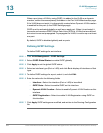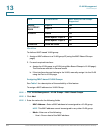
VLAN Management
Voice VLAN
Cisco Small Business 200, 300 and 500 Series Managed Switch Administration Guide (Internal Version) 213
13
The device supports a single voice VLAN. By default, the voice VLAN is VLAN 1.
The voice VLAN is defaulted to VLAN 1. A different voice VLAN can be manually
configured. It can also be dynamically learned when Auto Voice VLAN is enabled.
Ports can be manually added to the voice VLAN by using basic VLAN
configuration described in the Configuring VLAN Interface Setting section, or by
manually applying voice-related Smartport macro to the ports. Alternatively, they
can be added dynamically if the device is in Telephony OUI mode, or has Auto
Smartports enabled.
Dynamic Voice VLAN Modes
The device supports two dynamic voice VLAN modes: Telephony OUI
(Organization Unique Identifier) mode and Auto Voice VLAN mode. The two
modes affect how voice VLAN and/or voice VLAN port memberships are
configured. The two modes are mutually exclusive to each other.
• Telep hony OUI
In Telephony OUI mode, the voice VLAN must be a manually-configured
VLAN, and cannot be the default VLAN.
When the device is in Telephony OUI mode and a port is manually
configured as a candidate to join the voice VLAN, the device dynamically
adds the port to the voice VLAN if it receives a packet with a source MAC
address matching to one of the configured telephony OUIs. An OUI is the
first three bytes of an Ethernet MAC address. For more information about
Telephony OUI, see Configuring Telephony OUI.
• Auto Voice VLAN
In Auto Voice VLAN mode, the voice VLAN can be either the default voice
VLAN, manually configured, or learned from external devices such as
UC3xx/5xx and from switches that advertise voice VLAN in CDP or VSDP.
VSDP is a Cisco defined protocol for voice service discovery.
Unlike Telephony OUI mode that detects voice devices based on telephony
OUI, Auto Voice VLAN mode depends on Auto Smartport to dynamically
add the ports to the voice VLAN. Auto Smartport, if enabled, adds a port to
the voice VLAN if it detects an attaching device to the port that advertises
itself as a phone or media end points through CDP and/or LLDP-MED.


















